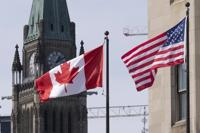With monetary policy at the Bank of Canada and U.S. Federal Reserve diverging, experts say it could set the Canadian dollar up for volatility down the road.
In a widely expected move, the Fed on Wednesday afternoon held its key rate steady, a week after the Bank of Canada announced a cut.
If the Bank of CanadaŌĆÖs rate falls too far below the FedŌĆÖs, it could negatively affect the loonie, said Allan Small, senior investment adviser at IA Private Wealth. This would make imports from the U.S.ŌĆö Canada's biggest trading partner ŌĆö more expensive and put upward pressure on inflation, though he added this isnŌĆÖt something that happens overnight.
ŌĆ£If the Bank of Canada cuts a few times and the Fed stands pat, I don't think that will be an issue,ŌĆØ he said.
But if the Bank of Canada keeps cutting and the Fed holds on past the first quarter of next year, ŌĆ£then we could start to see significant divergence.ŌĆØ
The U.S. economy has been more resilient than expected in the face of higher borrowing costs and inflation.
ŌĆ£WeŌĆÖll need to see more good data to bolster our confidence that inflation is moving sustainably toward two per cent,ŌĆØ Fed chair Jerome Powell said at a news conference Wednesday.
ItŌĆÖs a different story in Canada, where last week, the Bank of Canada announced its first interest rate cut in more than four years after a steep hiking cycle aimed at tamping down inflation.
At a June 5 press conference discussing the rate cut, governor Tiff Macklem said the central bank has more confidence that inflation is heading toward its two per cent target.
He acknowledged there are limits to how far the Bank of Canada can diverge from the U.S. in terms of rate policy, but he said ŌĆ£weŌĆÖre not close to those limits.ŌĆØ
The Bank of Canada cut its key lending rate by a quarter of a percentage point to 4.75 per cent while the U.S. federal funds rate currently sits at 5.25 per cent to 5.50 per cent. The European Central Bank also announced its first cut last week.
CanadaŌĆÖs economy is more sensitive to interest rates than the U.S.', in large part because Canadians have five-year mortgage terms, while in the U.S., terms are 30 years, said Brianne Gardner, senior wealth manager of Velocity Investment Partners at Raymond James Ltd.
This means far more Canadian homeowners have had to renew their mortgages during this period of higher rates, which has led consumers to rein in their spending.
ŌĆ£ItŌĆÖs really a tale of two economies,ŌĆØ said Small.
The Canadian market also depends more on commodities like oil, said Small, whereas tech companies make up a large portion of financial markets in the U.S. ŌĆö and major tech names have been leading a recent rally in equities over optimism about artificial intelligence.
ŌĆ£That has gone a long way to produce the earnings, to produce the growth, and to give the United States a definite advantage,ŌĆØ said Small.
ItŌĆÖs not uncommon for the overnight rates between the two countries to diverge somewhat, said Gardner, but itŌĆÖs not usually a significant difference.
Historically, a difference of 100 basis points, or one percentage point, has been a ŌĆ£comfort zone,ŌĆØ she said.
ŌĆ£If there is that window, I would say we're still comfortable with that. If it starts to get a little bit outside that, I think we might reassess.ŌĆØ
ŌĆ£I think thereŌĆÖs more room for divergence than most people think,ŌĆØ said Gardner.
For a period in the 1990s, the difference between the two rates was 250 basis points, which is ŌĆ£quite a large spread,ŌĆØ said Gardner.
During that period, however, strength in energy prices helped buoy the loonie, said Gardner.
ŌĆ£If energy prices continue to rise, that could be a buffer for the Canadian dollar.ŌĆØ
At the beginning of 2024, market watchers thought the Fed could cut its key rate six times throughout the year, even though the central bank itself was projecting three cuts. Those expectations have been significantly pared back as economic data rolled in over the past six months.
On Wednesday, new projections from the Fed showed it expects just one rate cut in 2024.
According to data from CME Group, the market is pricing in a roughly 60 per cent chance of the first cut coming in September, and roughly 45 per cent odds of a second cut in December.
Small says depending on how the U.S. economy holds up as the year progresses, itŌĆÖs possible the Fed wonŌĆÖt cut at all until 2025.
However, investors hoping for lower rates got a boost of optimism Wednesday morning as they waited for the central bank's decision later in the day. A new report showed consumer price inflation in May eased for the second straight month, coming in at 3.3 per cent compared with what economists expected, which was 3.4 per cent.
Powell said the Fed welcomes the May inflation report, and hopes for more like it.
Macklem said last week that the Bank of Canada is taking its interest rate decisions ŌĆ£one meeting at a time.ŌĆØ
"If inflation continues to ease, and our confidence that inflation is headed sustainably to the two per cent target continues to increase, it is reasonable to expect further cuts to our policy interest rate," he said.
ŌĆ£The Bank of Canada says that they have a lot of room to diverge,ŌĆØ said Small, but he added itŌĆÖs not clear how much room that actually is.
ŌĆ£At some point, if the U.S. does not start cutting ... it could present some difficulty, for sure.ŌĆØ
ŌĆö With files from The Associated Press
This report by ŽŃĖ█┴∙║Ž▓╩╣ę┼Ųū╩┴Ž was first published June 12, 2024.








































